With email campaigns, you get a direct line to your customers.
The return on email marketing is insane. For every $1 spent, you can make $42. It’s one of the most cost-effective marketing tools out there.
But sending email campaigns that convert is the real battle.
Low open rate? Complexity of sending personalized email marketing campaigns? Designing the layout? The hurdles are many.
In this blog, we explain:
- What is an email campaign?
- Types of email marketing campaigns
- 9 Best email campaign examples
- How to create an email marketing campaign?
Send automated email campaigns with Retainful’s easy-to-setup email automation. Automate in 3 clicks, not 3 pages.
What is an email campaign?
An email campaign involves sending one email or a series of emails to an audience to promote offers, nurture leads, or recover abandoned carts.
Email marketing campaigns are sent using email automation tools based on customer behavior or specific timeframes.
Here is an example of a welcome email drip campaign.
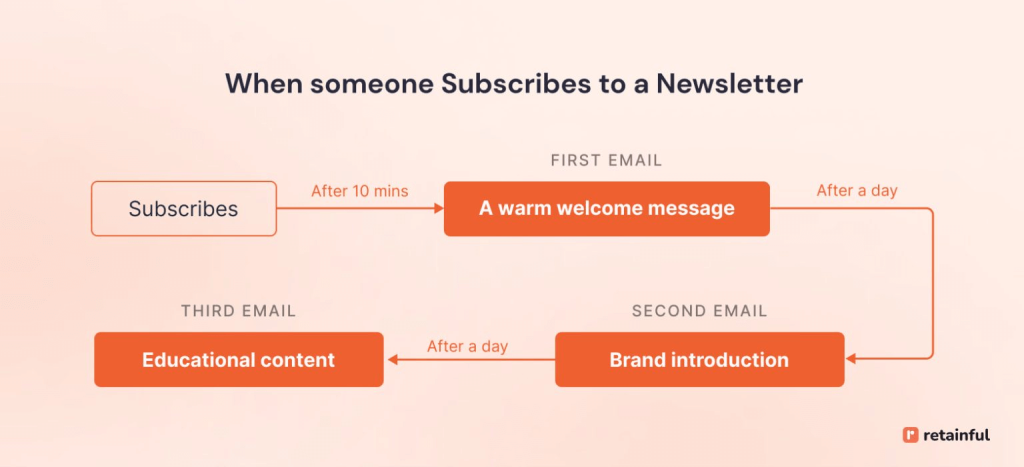
Different types of email campaigns to send
You can send different types of email marketing campaigns based on the customer’s position in the email marketing funnel. Some have just subscribed and some already have been your repeat customer.
The email marketing campaign strategy is to not send the same email marketing campaign to every customer. A new customer isn’t ready to refer someone or join a loyalty program, so sending them a referral program email campaign would be shooting bullets in the dark.
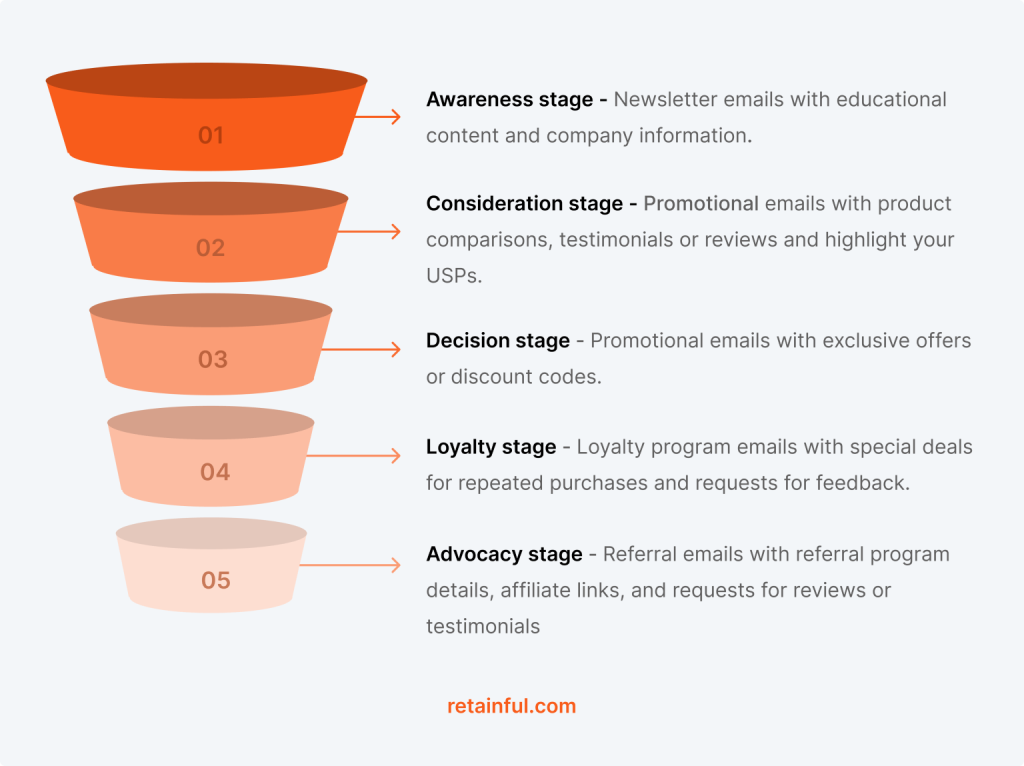
Here are the types of email campaigns to send at each stage of the email marketing funnel.
Awareness Stage
The top-of-the-funnel email marketing campaigns you can send are a welcome email campaign or a nurturing email campaign.
Consideration Stage
The types of email drip campaigns to send in this stage are tips//how-to guide email newsletters or case studies.
Decision Stage
The types of email marketing campaigns you can send at this stage are limited-time offers emails, abandoned cart emails, and product comparisons with competitors.
Loyalty state
You can send thank you emails, loyalty program emails, and VIP offer emails.
Advocacy stage
At the advocacy stage, you can send referral campaign emails and review request emails.
9 Best Email Campaign Examples
1. Welcome series email campaign example
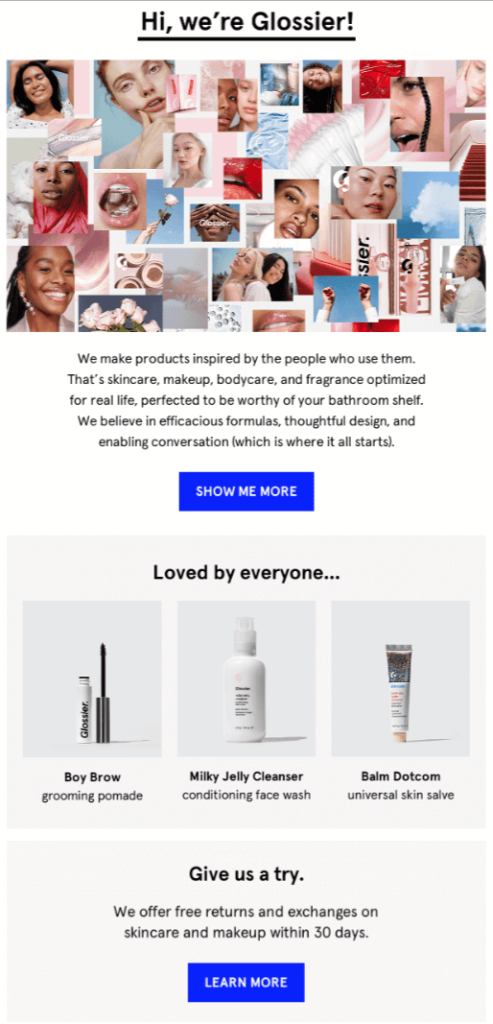
The short, casual tone of this welcome email campaign example makes the brand feel like a friend rather than a corporation, which is the perfect email marketing campaign strategy for a beauty and skincare brand.
Welcome series email campaign is where you explain where your brand stands for. Glossier does it by writing about values and not being overly promotional.
The CTAs in this email campaign example- “Show me more and ‘Learn more” also don’t pressurize the readers to purchase immediately.
What to include in your welcome email drip campaign:
- Showcase your top-sellers
- Handle objections and gain trust
- Convey what your brand stand for
- Don’t prompt the customer to purchase
2. Lead nurturing email campaign example

The headline of this email campaign template piques curiosity and makes readers think, “If it works for them, maybe it’ll work for me.”
Typeform shows us how to build credibility like a pro – showing case studies as social proof. This email marketing campaign strategy is perfect for prompting the customer to use the product without being too salesy.
In this email campaign for lead generation, each section smoothly transitions to the next, building momentum from the introductory headline to the inspiring case studies to the final CTA.
The CTA “Create a new form” is clear, actionable, and positioned at the end of the marketing email campaign template when the reader is most likely primed to take action.
What to include in your lead nurturing email campaign?
- Include case studies
- Use inspiration-driven language rather than promotional tone
3. Abandoned cart email campaign example

This abandoned cart email campaign example shows the product the recipient already checked out. It reinforces their interest and subtly encourages them to reconsider.
After showing the product they browsed, this ecommerce email campaign example smartly suggests complementary or similar products. Rael offers more reasons to click and shop.
More choices = more reasons to re-engage.
The tags at the bottom of this marketing email campaign template reinforce the brand’s values, building trust and making the reader feel good about purchasing.
This email drip campaign example smartly closes with additional ways to engage with the brand. Even if the recipient doesn’t buy right away, they can subscribe or refer a friend.
What to include in your abandoned cart email campaign:
- Visual reminder of browsed products
- Showcase related products
- Trust building elements to handle objections about making a purchase.
4. Post-purchase email marketing campaign

Homes Alive Pets nails this post-purchase email marketing campaign. It combines gratitude, support, and trust-building into a clear, visually appealing email campaign template.
The purchase summary is clear and simple, reminding the customer exactly what they bought.
By clearly showing they offer returns and nationwide shipping, this effective email campaign example is reducing friction and making future purchases more likely.
This ecommerce email campaign campaign example goes a step further, offering support information if the customer has any questions. This makes the company feel approachable and willing to help, reducing any post-purchase anxiety.
What to include in your post-purchase email drip campaign?
- Warm, personalized thank you.
- Reinforce the brand they chose is good
- Clear purchase summary
5. Feedback request campaign

After a purchase, customers are already in the post-purchase glow. They’re more likely to refer friends when they’re excited about the product. The best email marketing campaign strategy is to capitalize on this positive sentiment and ask for a review.
In this email campaign example, they’ve taken something as simple as a review request and made it fun. For example, “Write stuff” is a clever play on words.
The CTA of this email campaign template is super clear – no fluff, no distractions. Sundays knows exactly what they want: a review. The button is bold, inviting, and leaves no room for ambiguity.
In this feedback-request email campaign example, they’ve also framed the referral program as a win-win.
What to include in your email marketing campaign:
- Don’t just ask, “What did you like?”, ask, “What can we improve?”
- Images that reinforce the brand identity
- Playful, on-brand language
Send both pre and post-purchase email campaigns with Retainful and drive repeat sales.
6. Product launch email campaign

The preorder CTA button is right under the hero image – exactly where it needs to be. They don’t wait for you to scroll down through paragraphs of text before hitting you with the action step.
This marketing email campaign template includes just the right amount of features to build curiosity, but it’s not overwhelming. They pick the key selling points. No clutter, just the essentials.
Words like “masterfully” create the sense that Sonos has spent years honing these headphones. It makes it sound like it’s not just another launch.
What to include in your email marketing campaign template:
- Same and multiple CTAs (avoids confusion)
- Feature breakdown
7. Upsell/cross-sell campaign
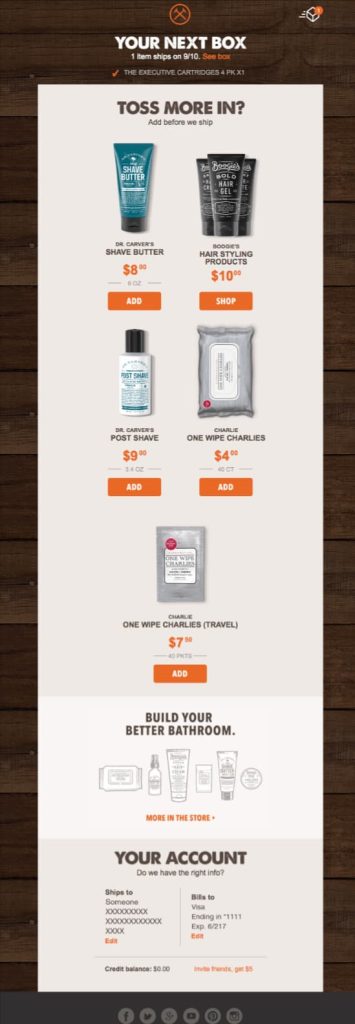
This cross-sell email marketing campaign example creates a natural lead-in for the upsell – since the order’s already being processed, tossing in something extra feels like no big deal.
It feels like a friendly suggestion from a buddy rather than a hard sell.
This email marketing campaign example has a curated selection of products customers can add with one click. No overwhelming you with 20+ options. Just 4-5 products that complement what you’re already getting.
By reminding customers to double-check their shipping and billing info, this marketing email campaign template subtly reduce friction for future purchases. It makes customers feel secure about their order.
Should you include upsell/cross-sell in your order confirmation emails?
Since the purchase decision has already been made, customers are in a spending mindset. A subtle upsell at this moment can nudge them into adding another item, boosting your average order value without feeling forced.
What to include in your email marketing campaign template:
- Include only the products related to the main product
- State how much the discount is if purchased together
8. Seasonal sale campaign

Black Friday is THE event of the year for both shoppers and retailers. Sending a Black Friday email as part of a seasonal email marketing campaign is a must in e-commerce email marketing.
The main offer is communicated clearly, with the terms of the discount – “VALID THROUGH NOV 26 & ONE-TIME USE ONLY” – being immediately visible.
The Black Friday email campaign example clearly states the promo code “BLACKFRIDAY” to be used at checkout. By placing the code directly below the main offer, it reduces any potential friction for customers who want to take advantage of the deal.
What to include in your seasonal email campaign?
- Segmented products into best sellers and newly launched
- Easy-to-find promo code
- Clear communication of the main offer
9. Re-engagement email campaign

Most customers lapse when they feel the product or service no longer meets their evolving needs or expectations.
Even if they have lapsed, their pain point remains the same. Through re-engagement email campaigns, reiterating the benefits of your product reminds customers how you can still help them solve their pain points.
This best win-back customer email campaign example uses concise and straightforward messaging like “We’ve leveled up – Come see what’s new!” to pique the user’s interest and convey the improvements without being too wordy.
What should you include in your email marketing campaign:
- Addressed the objection of lack of new products or improvement.
- Catchy tagline
- Included benefits of rejoining
How to create an email marketing campaign?
Step 1. Know Your Why (Set a Goal)
Before you even think about writing the email, ask yourself: What’s the point?
- Are you trying to increase sales?
- Maybe it’s about building trust with your audience.
- Or perhaps you just want people to read your blog post.
The first step in developing an email campaign is to have one clear goal. You can’t do everything in one email drip campaign. Keep it focused. Define your key goal upfront.
Step 2. Use email campaign automation
You can use email automation to send an email campaign sequence automatically at well-timed intervals.
Choose an email marketing software that has easy-to-setup automation to take the pressure off you in setting up automation workflows.
Here is what an email marketing campaign workflow looks like:
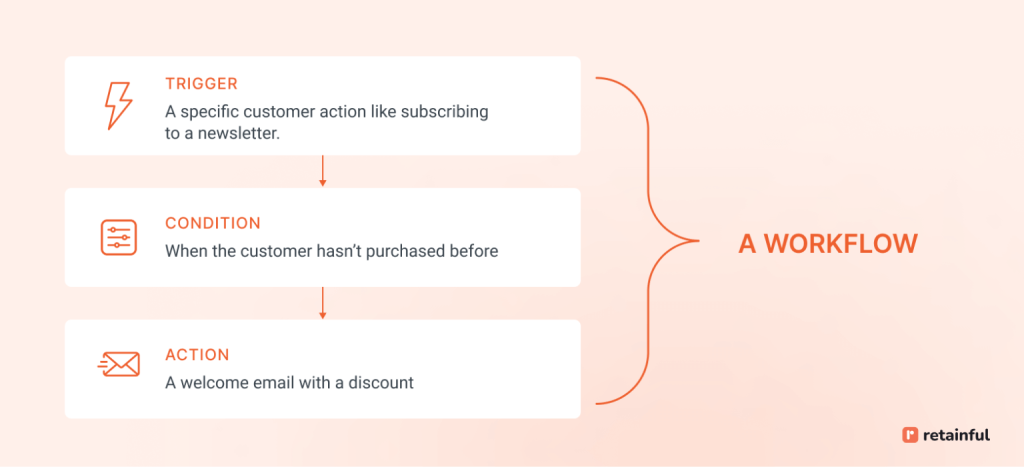
Here is how to set up an email marketing campaign:
- Choose the customer action to trigger the automated email campaign. Example: Sign up for the newsletter or a purchase.
- Choose which segment of your audience should receive it
- Set up the email campaign sequence and the time delay between them.
Step 3. Choose Your Audience (Segment Like a Pro)
Here’s where most email marketers mess up – they blast emails to everyone. But not everyone cares about the same thing. The key to send high-converting email campaigns? Segmenting your customers.
- Have they purchased from you before? Send them product updates.
- Are they new subscribers? Give them a warm welcome.
Segmented email campaigns have the potential to have a 760% increase in revenue.
Use data to group people based on their behavior, purchase history, email engagement metrics and where they are in your funnel and use this to personalize your email campaigns.
Sending the right message to the right people is half the battle. The other half? Let’s get to that.
Step 4. Design the email campaign template
Keep your email campaign layout scannable. Nobody wants to read a wall of text.
Break the email campaign layout up with images, bullet points, or bold text. And focus on benefits, not features.
- Feature: “Our jacket is waterproof.”
- Benefit: “Stay dry, even in the wildest rainstorms.”
Your marketing email campaign CTA should be simple and unmissable. Use buttons like “Get Your Discount” or “Claim Offer”. Avoid weak phrases like “Click Here.” Keep the CTA above the fold and make it pop with color.
Tip: Don’t be afraid to repeat CTA at the bottom for those who read to the end.
Once they’ve clicked, you have seconds to keep them hooked with yout tagline.
Boring: “Thanks for subscribing to our newsletter.”
Better: “We’ve got something special for you today…”
Step 5: Track Performance (Know Your Numbers)
It doesn’t end after you hit send. You need to track how your email campaigns performed.
Here are some email marketing campaign metrics to track:
- Open rate: How many people actually opened your email? If this is low, your subject line needs work.
- Click-through rate (CTR): How many people clicked on your CTA? If this is low, the email content or CTA needs tweaking.
- Conversions: How many people followed through on your desired action? If the email campaign conversion rate is low, check your landing page or offer.
To measure the success of an email campaign, use this data to optimize future campaigns.
Automated email campaigns are never a one-and-done thing. You should constantly be learning, tweaking, and improving.
How to increase the email campaign click-through rate?
If you think the real success of email marketing campaigns is in open rate. Think again.
Email campaign click-through rate is the ultimate metric that tells if you are getting money in return for the bucks spent.
Here are some strategies to increase the click-through rate of an automated email campaign.
Nail your CTAs
Make your Call-to-Action (CTA) stand out with action-oriented words like “Shop Now,” “Get Yours Today,” or “Claim Your Discount.”
Here is what NOT to do:
- Using generic phrases like “Click Here” or “Submit” doesn’t tell the reader what they’re getting.
- Too many CTAs
- Hidden or small CTA buttons
- Wrong color contrast
- Lack of urgency
- Unmobile-friendly CTA buttons
- Placing CTA below the fold
- Too much text around CTA
Optimize for mobile
Use responsive design and make your CTA buttons large enough to click easily on small screens.
Use scarcity tactics
Highlight phrases like “Only 10 left in stock” or “Few spots remaining” to encourage clicks based on the fear of missing out (FOMO).
Add a P.S. section
Use a P.S. line at the bottom of the email campaign template to reinforce your CTA. This can capture the attention of readers who skim through your email.
Test sending times
Try sending automated email drip campaigns at different times and days to see when your audience is most responsive. Tuesdays, Wednesdays, and Thursdays generally perform best.
Skip the design work with Retainful’s ready-made templates and drag-and-drop email editor.
Wrapping up!!
Email campaigns are direct, cost-effective, and when done right, they speak to your audience at exactly the right moment.
But let’s not sugarcoat it – getting it right isn’t always easy. Too many email marketing campaigns, and you annoy your subscribers. Too few, and they forget you exist. Use the best practices from these email campaign examples and send high-converting emails.
With the best email campaign software you don’t have to hustle for sending emails that really sell.
Learn more about email marketing:
- 10 Best Email Marketing Examples for 2024
- What is Email Marketing? – An Ultimate Beginner’s Guide
- Shopify Email Marketing: A Guide to Create Email Marketing Campaigns
- How to Grow Your Email List Fast – 18 Ways + Techniques
Email marketing is the overall strategy of using emails to connect with your audience. An email campaign is a specific series of targeted emails within that strategy aimed at achieving a particular goal, like promoting a product or event.
The best days to send email campaigns are Tuesday, Wednesday, Thursday. The best times are 9 AM – 11 AM and 1 PM – 3 PM.
To format an email campaign: start with a compelling subject line, a personalized greeting, concise body text, relevant visuals, and a bold call-to-action.
Email campaigns can be a single email or a sequence of emails sent over time.
To set up an email campaign, choose an email marketing platform, design your email, write compelling copy, set automation rules, and schedule when the emails will be sent.
An email campaign flow is the sequence of emails sent to subscribers over time. It includes when emails are triggered, what content is included, and how recipients are moved through the funnel toward a goal, like a sale.
There’s no one-size-fits-all number, but typically, an email campaign includes 3 to 7 emails.
Email campaign duration depends on the goal, but a typical campaign runs from 1 week to 1 month. Automated sequences, like a welcome series, can last longer, while promotional campaigns are usually shorter and more time-sensitive.
Email campaigns are highly successful when executed well. With an average ROI of $42 for every $1 spent, they remain one of the most effective marketing channels out there.
Email campign success is measured by metrics like open rates, click-through rates (CTR), and conversions.
A good open rate varies by industry, but generally, anything between 15% to 25% is considered good.
